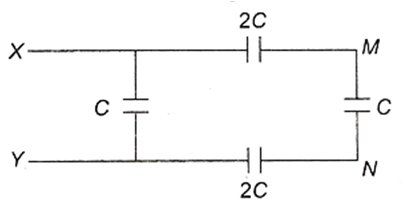 Multiple Choice Questions
Multiple Choice QuestionsFigure below shows four plates each of area A and separated from one another by a distance d

What is the capacitance between P and Q ?
A soap bubble is charged to a potential of 16 V. Its radius is, then doubled. The potential of the bubble now will be
16 V
8 V
4 V
2 V
4 point charges each +q is placed on the circumference of a circle of diameter 2d in such a way that they form a square. The potential at the centre is
0
64 identical spheres of charge q and capacitance C each are combined to form a large sphere. The charge and capacitance of the large sphere is
64q, C
16q, 4C
64q, 4C
16q, 64C
If the charge on a capacitor is increased by 2 coulomb, the energy stored in it increases by 21 %. The original charge on the capacitor is
10 C
20 C
30 C
40 C
Four capacitors of equal capacitance have an equivalent capacitance C1 when connected in series and an equivalent capacitance C2 when connected in parallel. The ratio is
1/4
1/16
1/8
1/12
In the figure below, the capacitance of each capacitor is 3 µF. The effective capacitance between A and B is

3 µF
6 µF
5 µF
In the adjoining figure, the potential difference between X and Y is 60 V. The potential difference between the points M and N will be

10 V
15 V
20 V
30 V
A, B and C are three points in a uniform electric field. The electric potential is

maximum at A
maximum at B
maximum at C
same at all the three points A, B and C
